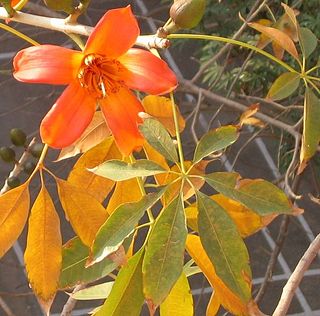The Kubitzki system is a system of plant taxonomy devised by Klaus Kubitzki, and is the product of an ongoing survey of vascular plants, entitled The Families and Genera of Vascular Plants, and extending to 13 volumes in 2015. [1] The survey, in the form of an encyclopedia, is important as a comprehensive, multivolume treatment of the vascular plants, with keys to and descriptions of all families and genera, mostly by specialists in those groups. The Kubitzki system served as the basis for classification in Mabberley's Plant-Book, a dictionary of the vascular plants. [2] Mabberley states, in his Introduction on page xi of the 2008 edition, that the Kubitzki system "has remained the standard to which other literature is compared".
Klaus Kubitzki is a German botanist. He is an Emeritus professor in the University of Hamburg, at the Herbarium Hamburgense. He is known for his work on the systematics and biogeography of the angiosperms, particularly those of the Neotropics, and also the floristic record of the Tertiary era. His plant systematic work is referred to as the Kubitzki system. He is a member of the American Society of Plant Taxonomists.

Vascular plants, also known as tracheophytes, form a large group of plants that are defined as those land plants that have lignified tissues for conducting water and minerals throughout the plant. They also have a specialized non-lignified tissue to conduct products of photosynthesis. Vascular plants include the clubmosses, horsetails, ferns, gymnosperms and angiosperms. Scientific names for the group include Tracheophyta, Tracheobionta and Equisetopsida sensu lato. The term higher plants should be avoided as a synonym for vascular plants as it is a remnant of the abandoned concept of the great chain of being.

An encyclopedia or encyclopædia is a reference work or compendium providing summaries of knowledge from either all branches or from a particular field or discipline. Encyclopedias are divided into articles or entries that are often arranged alphabetically by article name and sometimes by thematic categories. Encyclopedia entries are longer and more detailed than those in most dictionaries. Generally speaking, unlike dictionary entries—which focus on linguistic information about words, such as their etymology, meaning, pronunciation, use, and grammatical forms—encyclopedia articles focus on factual information concerning the subject named in the article's title.
Contents
In ordinal and family arrangements, the classification system in the initial angiosperm volumes closely resembles the Dahlgren system in Monocots and the Cronquist system in Dicots, but later volumes have been influenced by recent molecular phylogenetic studies.
In biological classification, the order is
- a taxonomic rank used in the classification of organisms and recognized by the nomenclature codes. Other well-known ranks are life, domain, kingdom, phylum, class, family, genus, and species, with order fitting in between class and family. An immediately higher rank, superorder, may be added directly above order, while suborder would be a lower rank.
- a taxonomic unit, a taxon, in that rank. In that case the plural is orders.
One of the modern systems of plant taxonomy, the Dahlgren system was published by monocot specialist Rolf Dahlgren in 1975 and revised in 1977, and 1980. However, he is best known for his two treatises on monocotyledons in 1982 and revised in 1985. His wife Gertrud Dahlgren continued the work after his death.
The Cronquist system is a taxonomic classification system of flowering plants. It was developed by Arthur Cronquist in a series of monographs and texts, including The Evolution and Classification of Flowering Plants and An Integrated System of Classification of Flowering Plants (1981).
The first volume of the series (Pteridophytes and Gymnosperms) covered lycophytes, monilophytes, and gymnosperms, and was published in 1990. By 2010, there were nine published volumes, covering 39 of the 59 orders of flowering plants that are recognized in the APG III system. The order Saxifragales is covered except for the genus Medusandra , which was transferred to it from Malpighiales in 2009. [3] Volume 10 (2011) covers the family Myrtaceae and the orders Cucurbitales and Sapindales. Volume 11 was published in 2014, and two further volumes in 2015. Volumes 2, and 5–7 address dicotyledons, while volumes 3, 4 and 13 address monocotyledons. Volumes 8–12 deal with eudicots.
The APG III system of flowering plant classification is the third version of a modern, mostly molecular-based, system of plant taxonomy being developed by the Angiosperm Phylogeny Group (APG). Published in 2009, it was superseded in 2016 by a further revision, the APG IV system.

The Saxifragales are an order of flowering plants. Their closest relatives are a large eudicot group known as the rosids by the definition of rosids given in the APG II classification system. Some authors define the rosids more widely, including Saxifragales as their most basal group. Saxifragales is one of the eight groups that compose the core eudicots. The others are Gunnerales, Dilleniaceae, Rosids, Santalales, Berberidopsidales, Caryophyllales, and Asterids.
Medusandra is a genus of flowering plants in the family Peridiscaceae. It has two species, Medusandra richardsiana and Medusandra mpomiana. M. richardsiana is the most common and well known. Both species are native to Cameroon and adjacent countries.
Because it is the result of a work in progress, the Kubitzki system is incomplete for those groups of plants that have not yet been covered, and groups that have been completely covered are not revised in light of subsequent knowledge. Since the first volume was published in 1990, a great deal has been learned about plant taxonomy, mostly by phylogenetic analysis of DNA sequences. The classification of ferns has been completely overhauled in that time. [4] [5] And some of the gymnosperm families have been revised. [6] [7]

Plants are mainly multicellular, predominantly photosynthetic eukaryotes of the kingdom Plantae. Historically, plants were treated as one of two kingdoms including all living things that were not animals, and all algae and fungi were treated as plants. However, all current definitions of Plantae exclude the fungi and some algae, as well as the prokaryotes. By one definition, plants form the clade Viridiplantae, a group that includes the flowering plants, conifers and other gymnosperms, ferns and their allies, hornworts, liverworts, mosses and the green algae, but excludes the red and brown algae.
Plant taxonomy is the science that finds, identifies, describes, classifies, and names plants. Thus making it one of the main branches of taxonomy.

A fern is a member of a group of vascular plants that reproduce via spores and have neither seeds nor flowers. They differ from mosses by being vascular, i.e., having specialized tissues that conduct water and nutrients and in having life cycles in which the sporophyte is the dominant phase. Ferns have complex leaves called megaphylls, that are more complex than the microphylls of clubmosses. Most ferns are leptosporangiate ferns, sometimes referred to as true ferns. They produce coiled fiddleheads that uncoil and expand into fronds. The group includes about 10,560 known extant species.
For the flowering plants, the later volumes of the Kubitzki System follows the Angiosperm Phylogeny Group last revised in 2009 (APG III system), except for the recognition of smaller families. (For a complete listing of all volumes, see Klaus Kubitzki)
The Angiosperm Phylogeny Group, or APG, is an informal international group of systematic botanists who collaborate to establish a consensus on the taxonomy of flowering plants (angiosperms) that reflects new knowledge about plant relationships discovered through phylogenetic studies.

Biological systematics is the study of the diversification of living forms, both past and present, and the relationships among living things through time. Relationships are visualized as evolutionary trees. Phylogenies have two components: branching order and branch length. Phylogenetic trees of species and higher taxa are used to study the evolution of traits and the distribution of organisms (biogeography). Systematics, in other words, is used to understand the evolutionary history of life on Earth.
In taxonomy, a segregate, or a segregate taxon is created when a taxon is split off from another taxon. This other taxon will be better known, usually bigger, and will continue to exist, even after the segregate taxon has been split off. A segregate will be either new or ephemeral: there is a tendency for taxonomists to disagree on segregates, and later workers often reunite a segregate with the 'mother' taxon.





